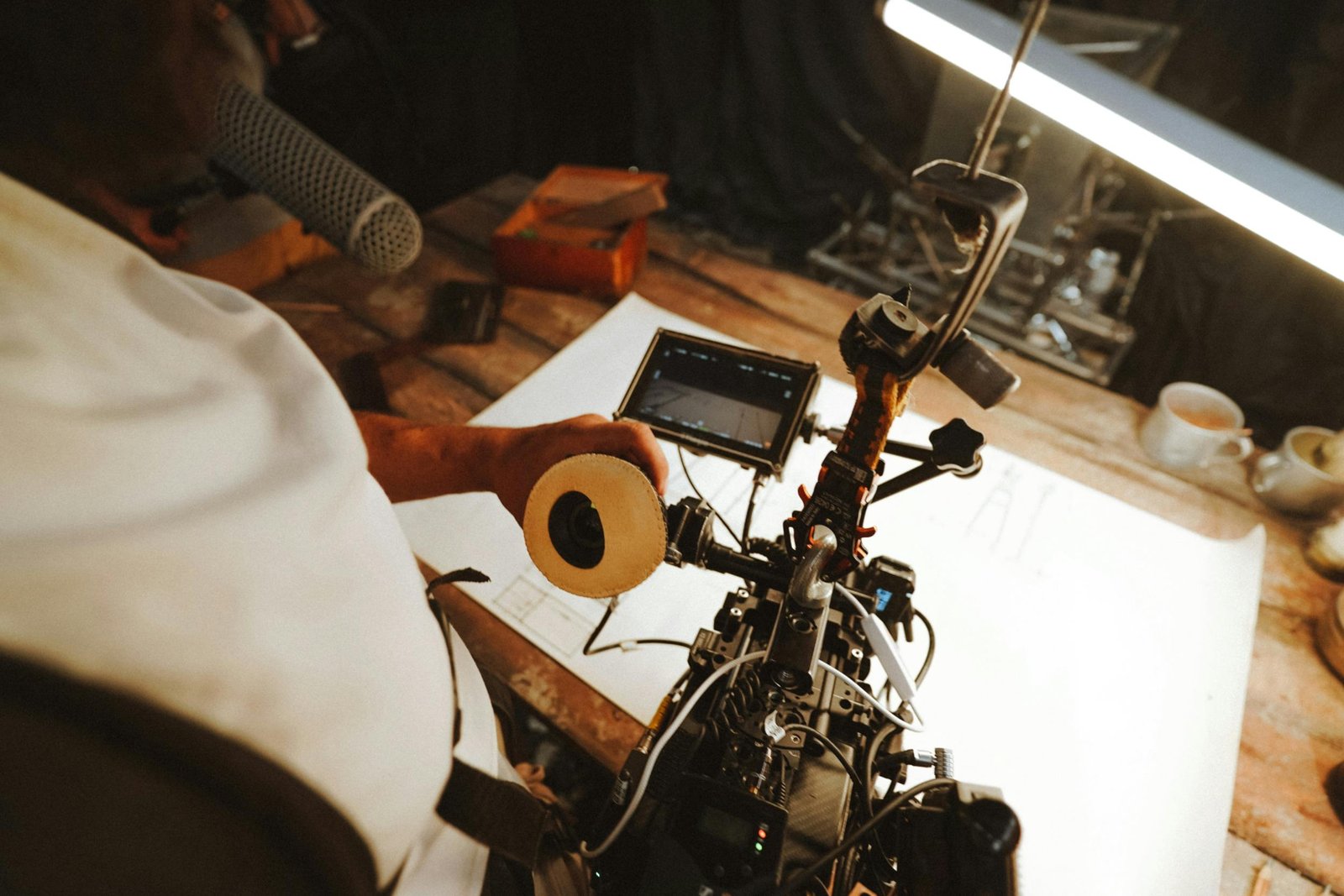Why Sustainable Production Practices Are Essential for Media Companies Introduction: The Growing Importance of Sustainability…
The Evolution of Augmented Reality in Media Production
Introduction
Augmented Reality (AR) is no longer just a futuristic concept; it has become a transformative force in media production. AR blends digital elements with the real world, offering a seamless experience that enhances what we see and interact with. This technology is revolutionizing how media is created, consumed, and engaged with, bringing new dimensions to storytelling, advertising, and entertainment. But how did AR evolve in the media industry, and what can we expect for its future? Let’s dive into this fascinating journey.
Early Beginnings of Augmented Reality
AR’s roots go back to the early days of computing, but its introduction to media production was slower. The term “augmented reality” was coined by Tom Caudell in the early 1990s, initially used for industrial purposes. However, the first applications in media were modest, with graphics and basic interactive elements. One of the earliest uses of AR in media was in the late 1990s when interactive graphics were used in live broadcasts. These first steps showed that AR could add an entirely new layer of interactivity to media production, laying the foundation for what would come next.
The Rise of AR in the Film Industry

The film industry was one of the first major sectors to harness AR technology, adding depth and immersion to movie-making. AR made its most notable appearance in Star Wars: The Phantom Menace (1999), where digital characters were seamlessly blended into live-action footage. This breakthrough paved the way for a wave of AR integration into filmmaking, allowing directors to visualize effects during production rather than relying on post-production.
As the technology advanced, films like Avatar (2009) used AR to create realistic, immersive worlds that were previously unimaginable. With more powerful AR tools, filmmakers began to experiment with interactive storytelling, making viewers feel more like they were part of the world on screen.
AR in Television and Broadcasting
Television and broadcasting also quickly saw the potential of AR. From sports broadcasts to news shows, AR is used to add digital elements, making content more engaging and informative. For instance, during live sports broadcasts, AR can be used to display real-time stats, player info, and 3D graphics that enhance the viewer’s experience. This innovation draws the audience in, providing a deeper connection with the event.
In news programs, AR technology allows for interactive weather maps, graphics, and even live demonstrations of stories. By integrating AR, broadcasters can transform simple news reports into visually compelling narratives.
The Impact of AR on Video Games and Interactive Media
One of the most exciting areas where AR has flourished is in the world of video games and interactive media. Games like Pokémon GO and Harry Potter: Wizards Unite have brought AR to the forefront, offering immersive experiences where players interact with the real world. These games use a smartphone’s camera and GPS to place digital objects and characters into the physical environment, transforming how users play games.
AR has also opened up new opportunities for interactive storytelling, where the audience’s actions can affect the outcome of the narrative. This shift has paved the way for an entirely new genre of entertainment, combining traditional gaming with real-world interaction.
AR in Advertising and Marketing
AR has changed the way brands communicate with consumers. With AR, companies can create immersive ads that encourage customer engagement in entirely new ways. For instance, brands like IKEA use AR apps to allow customers to visualize how furniture would look in their homes before making a purchase. This creates a personalized experience, building a stronger connection between the brand and the consumer.
Another great example is AR billboards or advertisements that come to life when viewed through a smartphone, offering a dynamic and interactive experience for consumers. This integration of AR in advertising not only boosts consumer engagement but also elevates the brand’s image by showing innovation and creativity.
Technological Advancements and the Future of AR
As AR technology continues to evolve, it’s increasingly integrated with other advanced technologies, such as 5G networks and artificial intelligence (AI). With the speed of 5G, AR applications can run seamlessly without the need for high-end devices, making AR more accessible to a broader audience. AI helps make AR experiences smarter, with more realistic digital interactions and personalized content.
Looking to the future, we can expect AR to become even more immersive. Virtual reality (VR) and AR will likely merge to create even more interactive media experiences. The boundaries between digital and physical worlds are slowly dissolving, and AR will play a pivotal role in this transformation.
Challenges and Limitations of AR in Media
Despite its advancements, AR faces significant technical challenges in media production. One of the main obstacles is the need for powerful hardware and software, which can limit the accessibility of AR experiences. Additionally, AR requires precise tracking and synchronization of digital and physical elements, which can be difficult to maintain in real-time.
Another challenge is privacy and security. AR applications often rely on cameras and sensors to collect data about the real world, which raises concerns about the misuse of personal information. Ethical concerns about data usage and consent are becoming more prominent as AR becomes more widespread in media production.
AR and the Role of Social Media Platforms

Social media platforms have played a significant role in popularizing AR through features like filters and virtual try-ons. Platforms like Snapchat, Instagram, and Facebook have made AR a part of daily life, offering users a fun and interactive way to engage with content. For instance, AR filters allow users to add digital effects to their photos and videos, creating engaging and shareable content.
Brands have also leveraged AR on social media to connect with audiences in new and exciting ways. Virtual try-ons, which allow users to see how products like makeup or clothing will look on them, are becoming increasingly popular, offering a personalized shopping experience without the need to visit a store.
AR in Music and Live Performances
AR is also making waves in the music industry, enhancing live performances and concerts. Artists are incorporating AR into their shows, creating immersive experiences that go beyond traditional stage setups. For example, AR projections can bring a virtual set to life, or allow fans to interact with holographic versions of their favorite artists.
This technology not only enhances the concert experience for fans but also offers new creative possibilities for musicians and performers, expanding the ways in which music can be experienced live.
The Role of AR in Virtual and Augmented Reality Studios
As AR technology becomes more integrated into media production, specialized AR studios are emerging. These studios are equipped with cutting-edge tools and technology that allow for the seamless integration of AR into films, games, and live broadcasts. These studios also provide valuable resources for AR content creation, including motion capture and interactive design.
By focusing on AR-specific content creation, these studios are helping to push the boundaries of what’s possible in media production.
Economic Impact of AR in the Media Industry
The economic potential of AR in the media industry is enormous. From film production to advertising, AR opens up new revenue streams by offering innovative experiences for consumers. The demand for AR-powered content is growing, and companies are investing heavily in the technology to stay ahead of the curve.
As AR technology becomes more affordable and accessible, we can expect even more growth in its economic impact, benefiting both creators and consumers.
Ethical and Social Implications of AR in Media Production
The use of AR in media raises important ethical and social concerns, particularly around privacy and the potential for manipulation. As AR technology collects data from users, concerns about how this data is used and stored are becoming more prevalent. Additionally, AR has the potential to blur the lines between reality and fiction, leading to questions about its effects on human behavior and perception.
The Global Influence of AR on Media Production
Around the world, AR is becoming an integral part of media production. Countries such as the United States, South Korea, and Japan have been at the forefront of AR development, with extensive investments in both the technology and content creation. As global demand for AR content grows, media production companies are expanding their reach and creating AR experiences for international audiences.
Conclusion
The evolution of augmented reality in media production has been nothing short of remarkable. From humble beginnings to its current status as a game-changing technology, AR has revolutionized how we experience entertainment. As technology continues to advance, AR will play an even larger role in shaping the future of media production, offering endless possibilities for creativity, engagement, and innovation. For creators, businesses, and consumers, AR is here to stay.
Frequently Asked Questions (FAQs)
- What is augmented reality (AR) in media production?
AR in media production refers to the integration of digital elements into real-world environments, enhancing storytelling, gaming, advertising, and other media formats. - How has AR changed the film industry?
AR has revolutionized filmmaking by allowing directors to visualize digital elements in real-time, enhancing special effects and creating more immersive experiences. - What are some challenges faced by AR in media production?
Key challenges include the need for powerful hardware, privacy concerns, and the technical difficulties of synchronizing digital elements with the physical world in real-time. - How is AR used in social media?
Social media platforms use AR for interactive filters, virtual try-ons, and engaging ads, allowing users to experience content in new, exciting ways. - What does the future hold for AR in media production?
The future of AR in media production is incredibly promising, with advancements in AI, 5G, and immersive technologies paving the way for even more innovative experiences.




